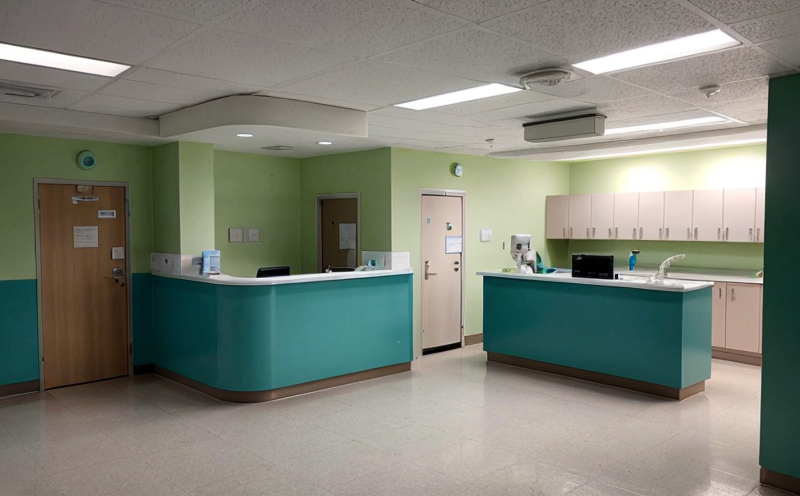EN 13697 Surface Antimicrobial Efficacy Testing in Healthcare Environments
The European Standard EN 13697 provides a protocol for evaluating the antimicrobial efficacy of disinfectants and other surface treatment products used in healthcare environments. This standard is particularly relevant to hospitals, clinics, and other facilities where hygiene and infection control are paramount.
Testing according to this standard ensures that the products used meet stringent requirements set by regulatory bodies. It helps quality managers and compliance officers ensure their facility meets all necessary standards for surface disinfection. R&D engineers can use EN 13697 as a guide when developing new antimicrobial agents or enhancing existing formulations.
The protocol involves several key steps including sample preparation, inoculation with test microorganisms, exposure to the disinfectant, and subsequent evaluation of microbial reduction. This section will delve into these details further, providing comprehensive information for those involved in healthcare facility management and product development.
EN 13697 is applicable to a variety of surfaces commonly found in hospitals such as floors, walls, medical equipment, and patient care areas. The standard specifies the conditions under which tests should be conducted to ensure accurate results reflecting real-world usage scenarios. Compliance with this standard can significantly enhance trust among stakeholders including patients, healthcare professionals, and regulatory authorities.
The protocol outlined in EN 13697 is designed to simulate actual conditions encountered during cleaning and disinfection procedures within healthcare settings. By following the prescribed methodology, laboratories can generate reliable data that supports informed decision-making regarding product selection and application practices. This not only improves patient safety but also contributes towards reducing healthcare-associated infections (HAI).
Understanding the nuances of this standard is crucial for those responsible for maintaining high standards of cleanliness in healthcare environments. Knowledge about the specific requirements laid out by EN 13697 allows facilities to implement effective strategies aimed at minimizing risks associated with microbial contamination.
| Standard | Description |
|---|---|
| EN 13697:2004 | European Standard for evaluating the antimicrobial efficacy of disinfectants and other surface treatment products used in healthcare environments. |
The application of EN 13697 ensures that the products being utilized are effective against a wide range of pathogens, thereby contributing to better patient outcomes. Compliance with this standard is essential for maintaining compliance with regulatory requirements and enhancing overall hygiene standards in healthcare facilities.
Applied Standards
| Standard | Description |
|---|---|
| EN 13697:2004 | This European Standard specifies the methods for evaluating the antimicrobial efficacy of disinfectants and other surface treatment products used in healthcare environments. |
The protocol described in EN 13697 ensures that the tests conducted are valid and consistent across different laboratories, thereby providing reliable data. This standard is widely recognized and accepted by regulatory bodies and industry experts alike, making it an essential tool for any facility seeking to maintain high standards of hygiene.
Benefits
- Ensures compliance with international regulatory requirements.
- Provides reliable data supporting informed decision-making regarding product selection and application practices.
- Contributes towards reducing healthcare-associated infections (HAI).
- Enhances overall hygiene standards in healthcare facilities.
- Promotes trust among stakeholders including patients, healthcare professionals, and regulatory authorities.
The benefits of adhering to EN 13697 are manifold. Not only does it ensure that the products being used meet strict standards set by regulatory bodies, but it also helps in generating reliable data which can be used for making informed decisions about product selection and application practices. By following this protocol, healthcare facilities can contribute towards reducing HAI rates significantly.
Why Choose This Test
The EN 13697 Surface Antimicrobial Efficacy Testing in Healthcare Environments is a crucial step for facilities aiming to maintain high standards of hygiene and prevent the spread of infections. Here are some reasons why choosing this test is beneficial:
- It provides accurate results reflecting real-world usage scenarios.
- The protocol ensures consistency across different laboratories.
- It supports informed decision-making regarding product selection and application practices.
- Promotes trust among all stakeholders, including patients and regulatory authorities.
- Facilitates compliance with international regulatory requirements.
Selecting the EN 13697 test offers numerous advantages for healthcare facilities. Accurate results are crucial in ensuring that the products being used are effective against a wide range of pathogens. Consistency across different laboratories ensures reliable data, while informed decision-making supports better patient outcomes. Ultimately, this test fosters trust among all stakeholders and contributes to maintaining high hygiene standards.





